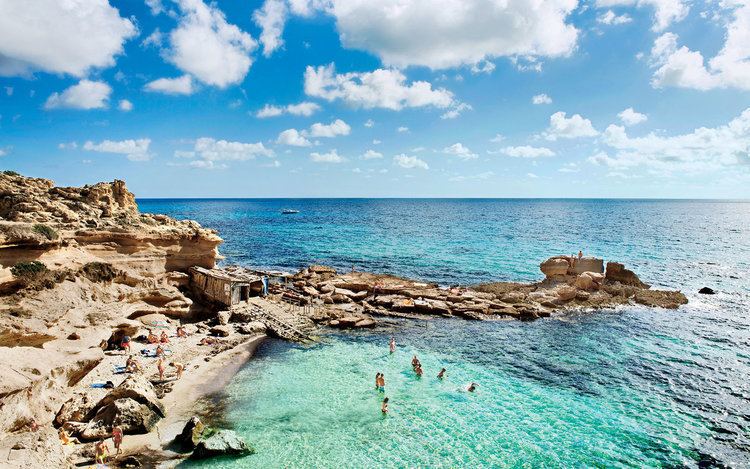Area 83.24 km² | Highest elevation 119 m (390 ft) Population 11,545 (2014) | |
 | ||
Pop. density 129.23 /km (334.7 /sq mi) Points of interest Ses Illetes, Cap de Barbaria, Levant, Faro de La Mola, Cala Saona | ||
Formentera balearic islands hd
Formentera ([furmənˈteɾə], [formenˈteɾa]) is the smaller and more southerly island of the Pityusic Islands group (comprising Ibiza and Formentera, as well as various small islets), which belongs to the Balearic Islands autonomous community (Spain).
Contents
- Formentera balearic islands hd
- Map of Formentera Balearic Islands Spain
- History
- Geography
- Attractions
- Transport
- Culture
- Sports
- References
Map of Formentera, Balearic Islands, Spain
History
The island's name is usually said to derive from the Latin word frumentarium, meaning "granary". The island had been occupied by the Carthaginians before passing to the ancient Romans. In succeeding centuries, it passed to the Visigoths, the Byzantines, the Vandals, and the Arabs. In 1109 it was the target of a devastating attack by the Norwegian king Sigurd I at the head of the "Norwegian Crusade". The island was conquered by the Catalans, added to the Crown of Aragon and later became part of the medieval Kingdom of Majorca.
The island (along with its surrounding islets) became a separate insular council (with the same territory as the municipality of the same name) after 1977. Before that, it was administered in the former insular council of Ibiza and Formentera (covering the whole group of the Pityusic Islands), but in a separate comarca (which already covered the current municipality of Formentera). This reform allowed Ibiza to unify its comarca (of five municipalities) with its new insular council (no longer administrating Formentera).
Geography
The main island of Formentera is 19 kilometres (12 mi) long and is located about 6 kilometres (4 mi) south of Ibiza in the Mediterranean Sea. More specifically Formentera is part of the delimitation of the Balearic Sea which is a northwestern element of the Mediterranean Sea. Its major villages are Sant Francesc Xavier, Sant Ferran de ses Roques, El Pilar de la Mola and La Savina.
Formentera comprises one municipality, also called Formentera, and has a population of 9,962 (as at 1 January 2010). Its land area is 83.24 square kilometres (32.1 sq mi). It is subdivided into several civil parishes (parròquies), themselves subdivided into vendas (véndes in Catalan).
North of Formentera is the island of Espalmador (Illa de s'Empalmador in Catalan), which is the second largest island of the municipality, and is itself surrounded by a few minor islets. Espalmador is a tombolo, separated from the main island of Formentera by a shallow sandbar, and during low tide, it is possible for one to wade between the two islands. This area is a popular stopping point for those in yachts heading between Ibiza and Formentera.
Attractions
Since the 1960s, Formentera has been a popular destination for hippies. Formentera is renowned across Europe for many pristine white beaches and the fact that nude sunbathing is allowed on most of its beaches. The Canadian writer Patrick Roscoe was born on Formentera. Meanwhile, Joni Mitchell wrote her 1971 album Blue on the island while Bob Dylan once lived in the Cap de Barbaria lighthouse on the island. Author Matt Haig also writes about visiting the island often in his twenties in Reasons to Stay Alive.
Although metalled roads allow access to all parts of the island and cars are easily hired in the port, many people choose to rent mopeds or even bicycles due to the flat nature of most of the island and the availability of dedicated cycle tracks in many locations.
The island also has four Martello towers.
Transport
The island was formerly reachable only by boat from Ibiza, making it the quieter of the two islands, but in recent years regular passenger service from the Spanish mainland has increased tourism.
Ferry tickets from Ibiza are available in advance, as are transfers from Ibiza airport or port directly to accommodation in Formentera.
Ferries to Formentera operate from their own terminal in Ibiza port, with departures every half hour in high season on large (200+ passenger) fast catamarans. The journey takes approximately 30 minutes with 10 minutes each leaving Ibiza, crossing the sea, and arriving in Formentera past the isthmus to Espalmador.
Culture
A local Ibizan (eivissenc) variant of the Balearic dialect of the Catalan language is spoken in Formentera. While the official languages are Catalan and Spanish, other major languages like English, Italian, German, French and Dutch can also be heard extensively in the summer due to mass tourism.
Sports
From 1 September to 7 September, Formentera hosted the 2007 Techno 293 OD World Championships in windsurfing for juniors under 15 and youths under 17.
